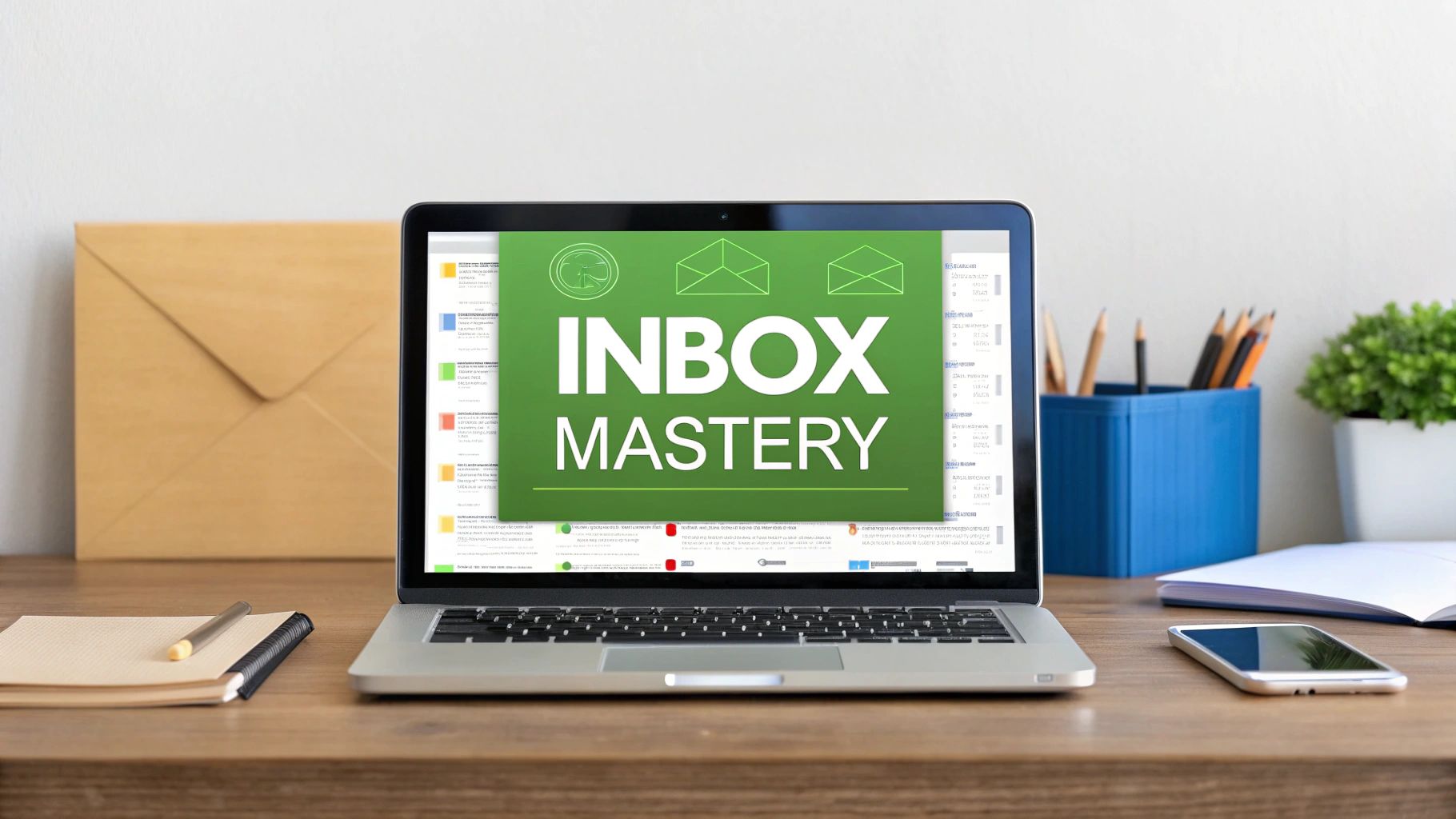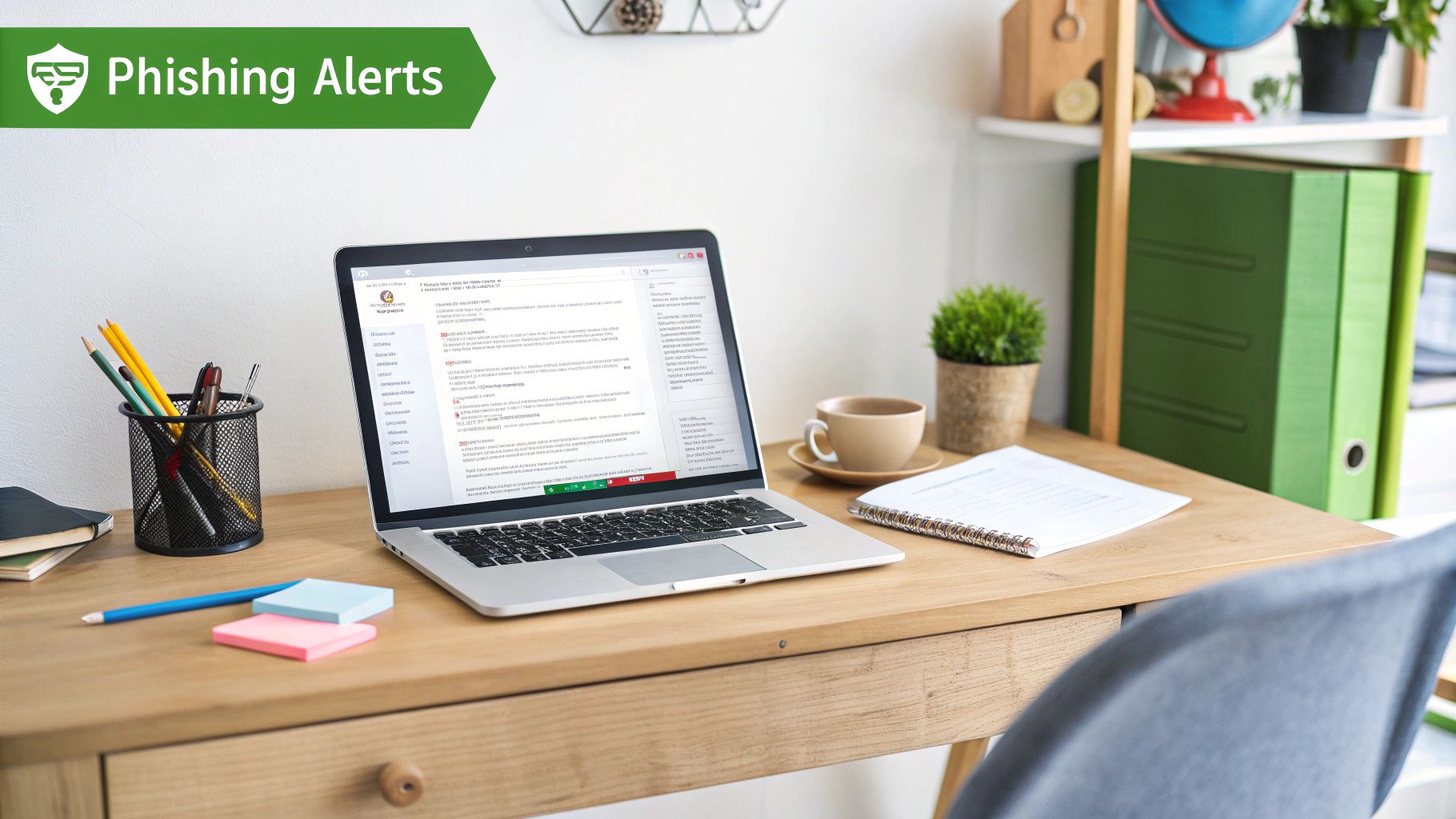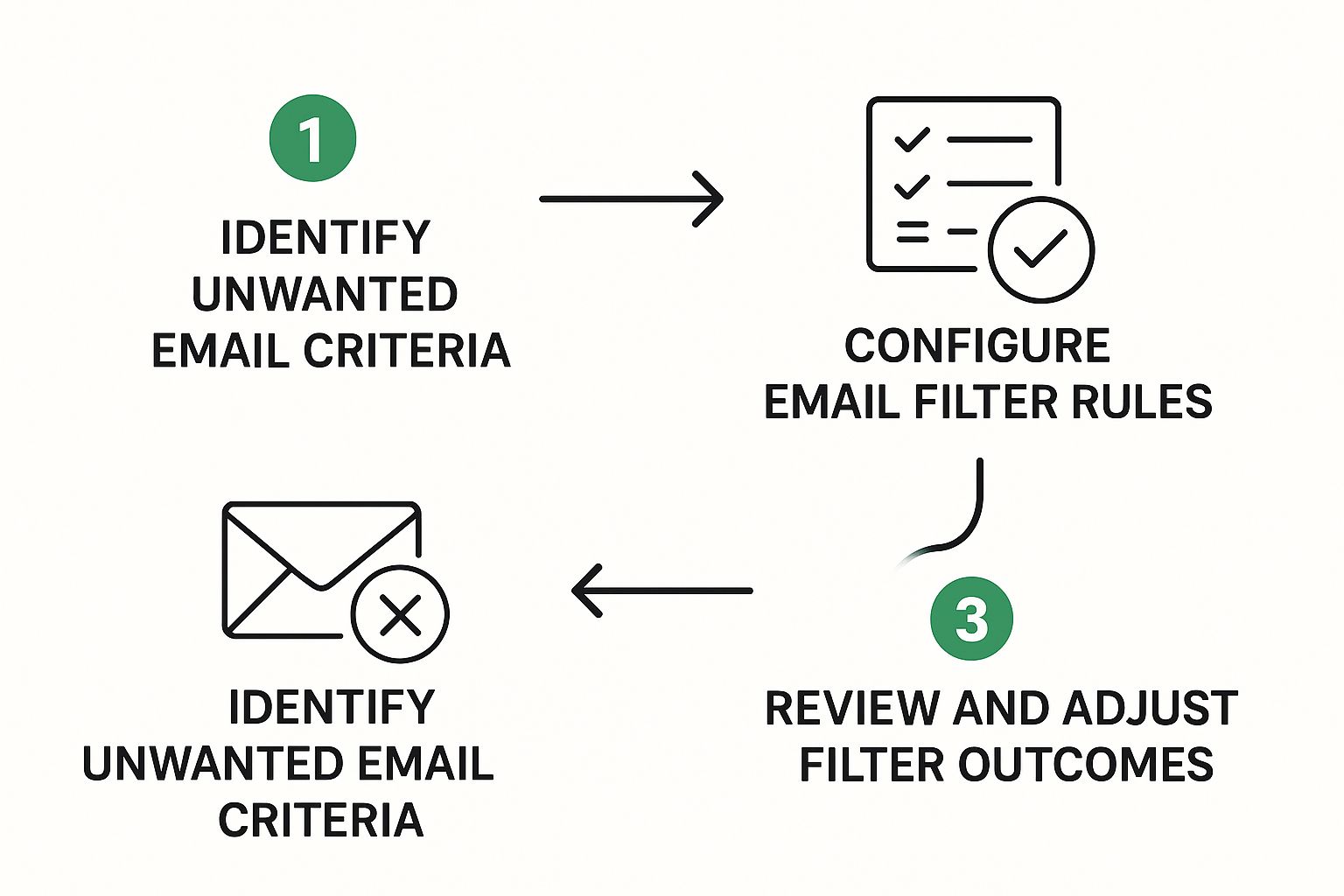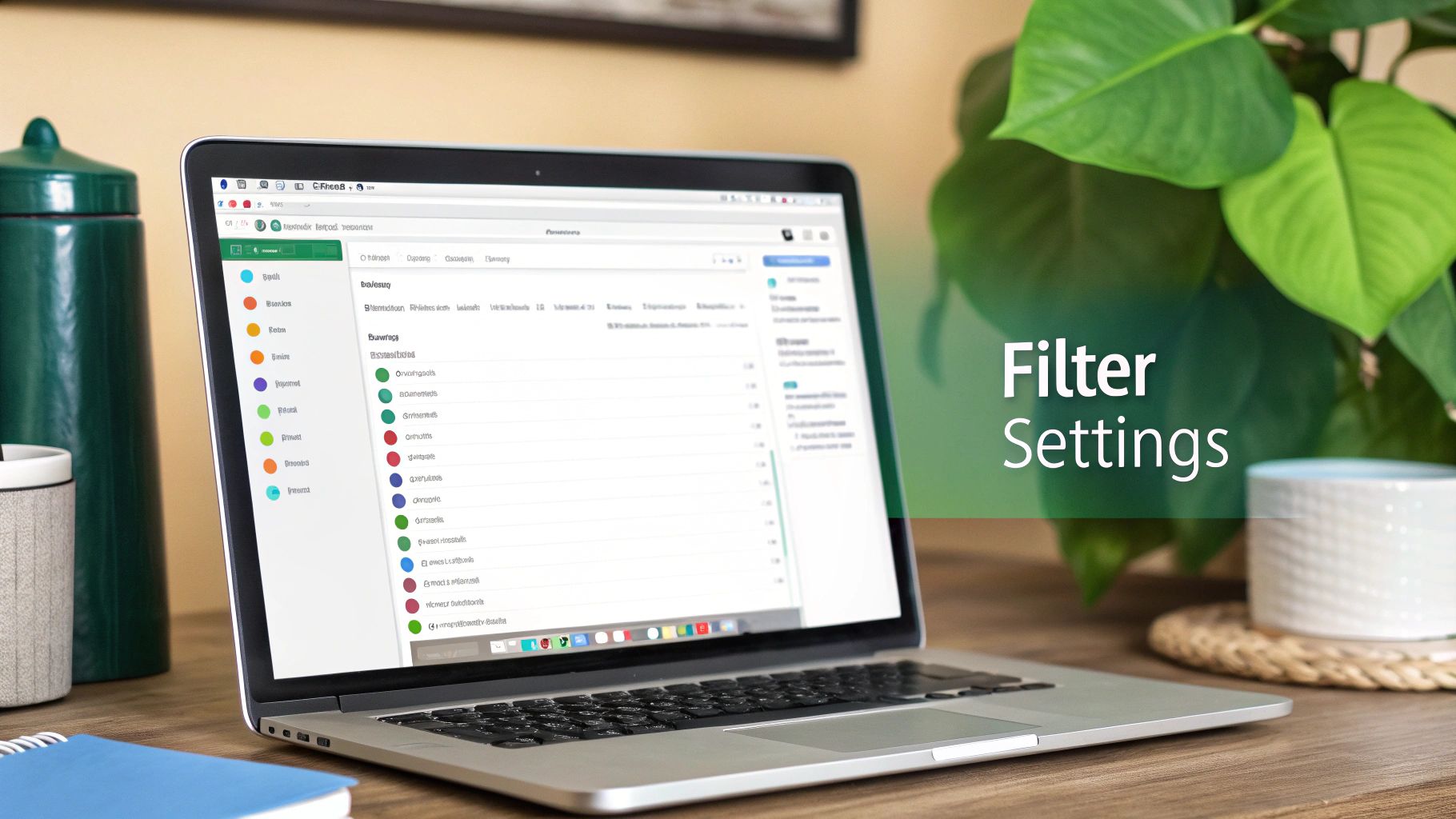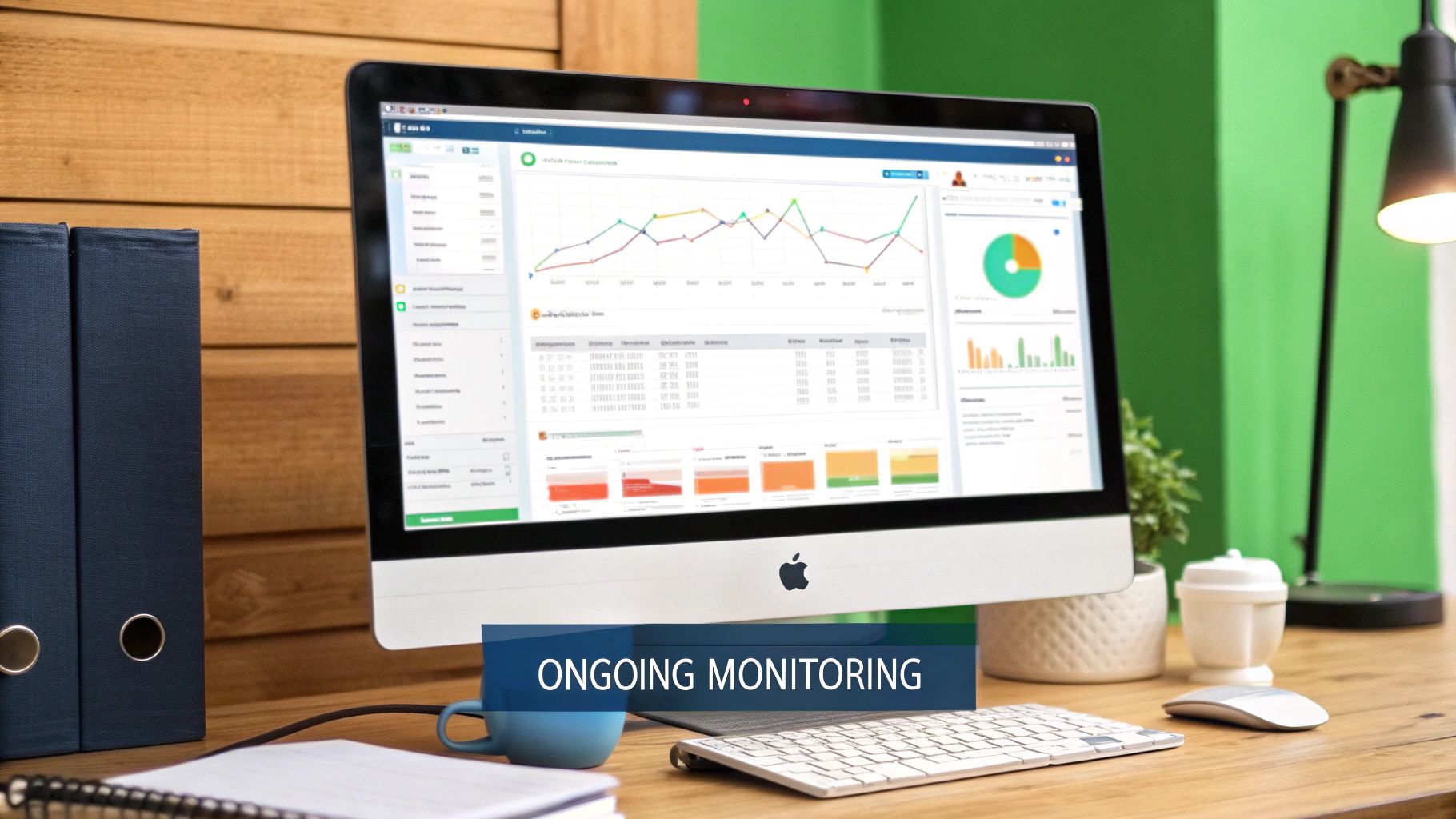Email is an indispensable communication tool, but it often becomes a source of stress and a major productivity bottleneck. The constant influx of messages, from critical business updates to promotional clutter, can feel overwhelming, leaving you buried under a digital avalanche. This feeling of being constantly reactive, rather than in control, is a common struggle for professionals and individuals alike. The key isn't just to work harder at clearing your inbox, but to work smarter with proven strategies that put you back in command.
This guide provides actionable tips for email management, moving beyond generic advice to offer specific, practical methodologies you can implement today. We will explore powerful techniques designed to transform your email from a chaotic mess into a streamlined, efficient, and secure communication hub. You will learn how to:
- Implement the disciplined 'Inbox Zero' methodology.
- Automate your workflow with strategic filtering and rules.
- Master your time with scheduled email processing and the two-minute rule.
- Optimize your communication with templates and clear etiquette.
By adopting these powerful strategies, you can build a truly robust and private email workflow. This approach becomes even more potent when paired with a secure platform that prioritizes user privacy and control. Let's reclaim your focus and master your inbox.
1. Inbox Zero Methodology
The Inbox Zero methodology, a concept popularized by productivity expert Merlin Mann, isn’t about having zero messages in your inbox. Instead, it's about spending zero mental energy on a cluttered inbox. This systematic approach treats your email inbox like a processing station, not a long-term storage unit. The core principle is to make a decisive action on every email as soon as you open it, preventing messages from piling up and causing stress.
By processing emails immediately, you regain control and focus. This method encourages you to handle each message with one of five actions: Delete, Delegate, Respond, Defer, or Do. This clear framework eliminates indecision and helps you manage your communications efficiently, a key reason why it's one of the most effective tips for email management. Companies like Buffer have successfully integrated this approach to boost team productivity and reduce digital clutter.
How to Implement Inbox Zero
To get started, follow a simple but powerful workflow for every email that arrives. This process turns a reactive habit into a proactive system.
- Set Specific Times: Instead of constant checking, dedicate specific blocks of time each day for email. This batch-processing technique improves focus on other important tasks.
- Bulk Archive Old Mail: The first step is to declare "email bankruptcy." Select all emails older than a week or two and archive them. This gives you a clean slate and reduces initial overwhelm.
- Follow the Two-Minute Rule: If an email requires a task that takes less than two minutes to complete, do it immediately. This prevents small tasks from accumulating.
- Create Response Templates: For recurring questions or common replies, use templates. This saves significant time and allows you to respond quickly and consistently.
The following process flow diagram illustrates the core decision-making loop of the Inbox Zero system.

This simple, repeatable loop ensures every email is processed decisively, clearing your inbox and your mind for more critical work.
2. Strategic Email Filtering and Rules
Strategic email filtering is an automated system that acts as your personal email assistant, sorting your inbox before you even see it. This method uses rules within your email client, like Gmail or Outlook, to automatically manage incoming messages based on criteria you set. By establishing rules for senders, keywords, or subject lines, you can direct emails to specific folders, apply labels, forward them, or even archive them, all without manual intervention. This system turns a chaotic inbox into a neatly organized workspace where important messages are immediately visible.
This automated approach is one of the most powerful tips for email management because it drastically reduces the manual effort needed to maintain order. Law firms, for instance, use filters to sort communications by client or case number, ensuring critical information is never lost. Similarly, project managers can create filters for specific project tags, keeping all related conversations grouped together for easy reference. This proactive organization prevents overwhelm and keeps your focus on high-priority tasks.
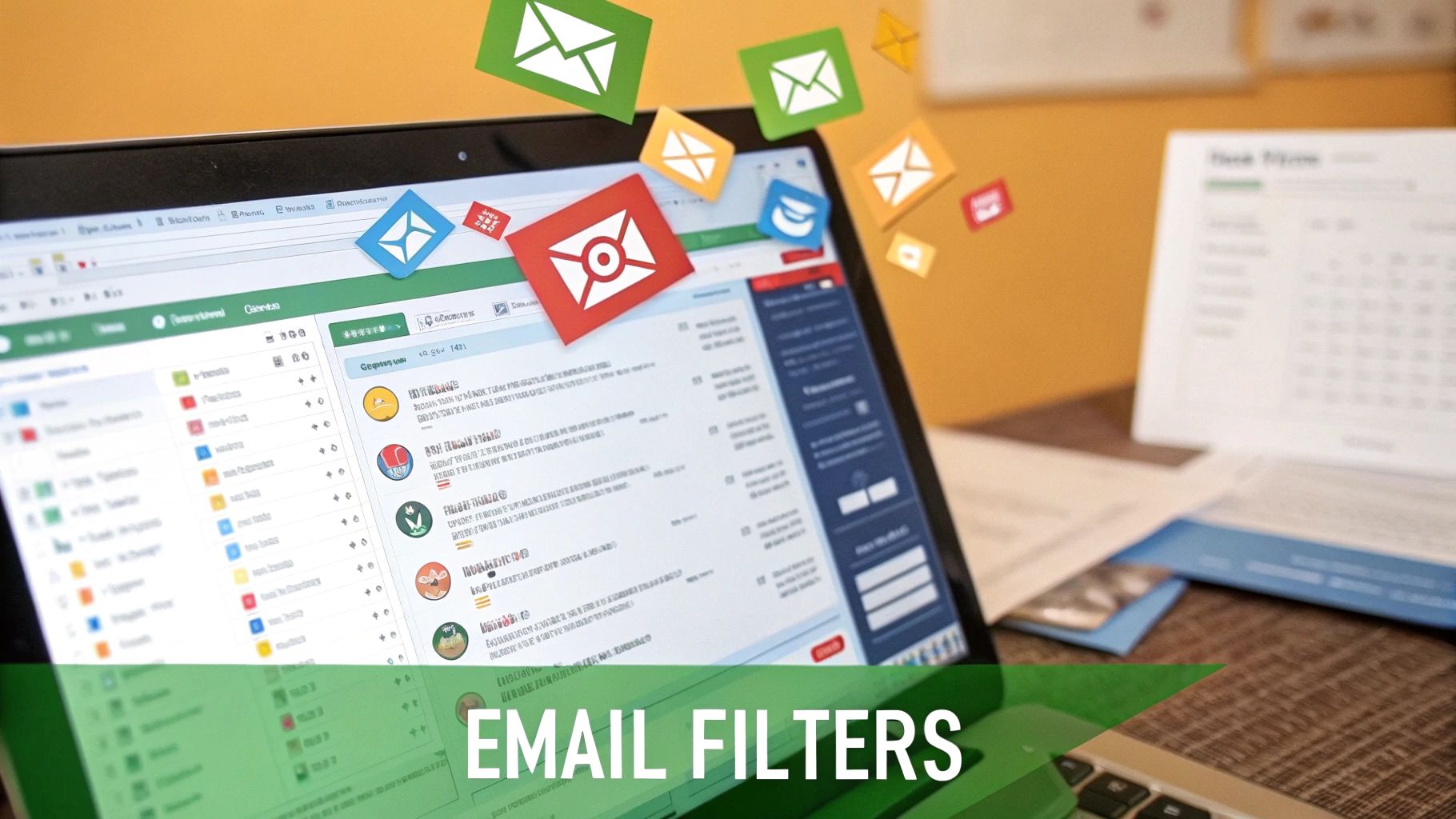
How to Implement Email Filters and Rules
Getting started with filters is about teaching your email client how to handle your mail. This transforms your inbox from a passive receptacle into an active, intelligent system.
- Start with Broad Categories: Begin by creating filters for high-level categories like "Newsletters," "Financial," or "Project X." You can refine these with more specific rules over time.
- Create a VIP Filter: Identify your most important contacts, such as your boss, key clients, or family members. Create a rule that stars, color-codes, or moves their emails to a priority folder so you never miss them.
- Filter by Keywords: Set up rules to automatically handle emails containing specific words. For example, a filter for the word "invoice" can move all bills to a "To Pay" folder, while a filter for "unsubscribe" can send promotional emails directly to the trash.
- Test Your Filters: Before applying a rule to your entire inbox, test it on a small selection of emails. This helps ensure it works as intended without accidentally misfiling important messages.
The video below offers a visual guide on setting up effective filters in popular email clients.
By implementing these rules, you build a customized system that manages your email for you, saving you valuable time and mental energy every day.
3. Scheduled Email Processing
Scheduled Email Processing is a time-blocking technique that transforms email from a constant interruption into a planned, focused task. Popularized by productivity experts like Tim Ferriss and Cal Newport, this method involves dedicating specific, pre-scheduled blocks of time each day solely for reading and responding to emails. Instead of letting your inbox dictate your workflow, you treat it like any other scheduled appointment, preventing it from derailing your concentration on more critical work.
This approach is one of the most effective tips for email management because it reclaims your focus. By batching email tasks, you reduce the cognitive cost of context switching and maintain deep work states for longer periods. High-performers like former Twitter CEO Jack Dorsey have famously used this method, often limiting email processing to the beginning and end of the day, to protect their most productive hours and maintain strategic focus.
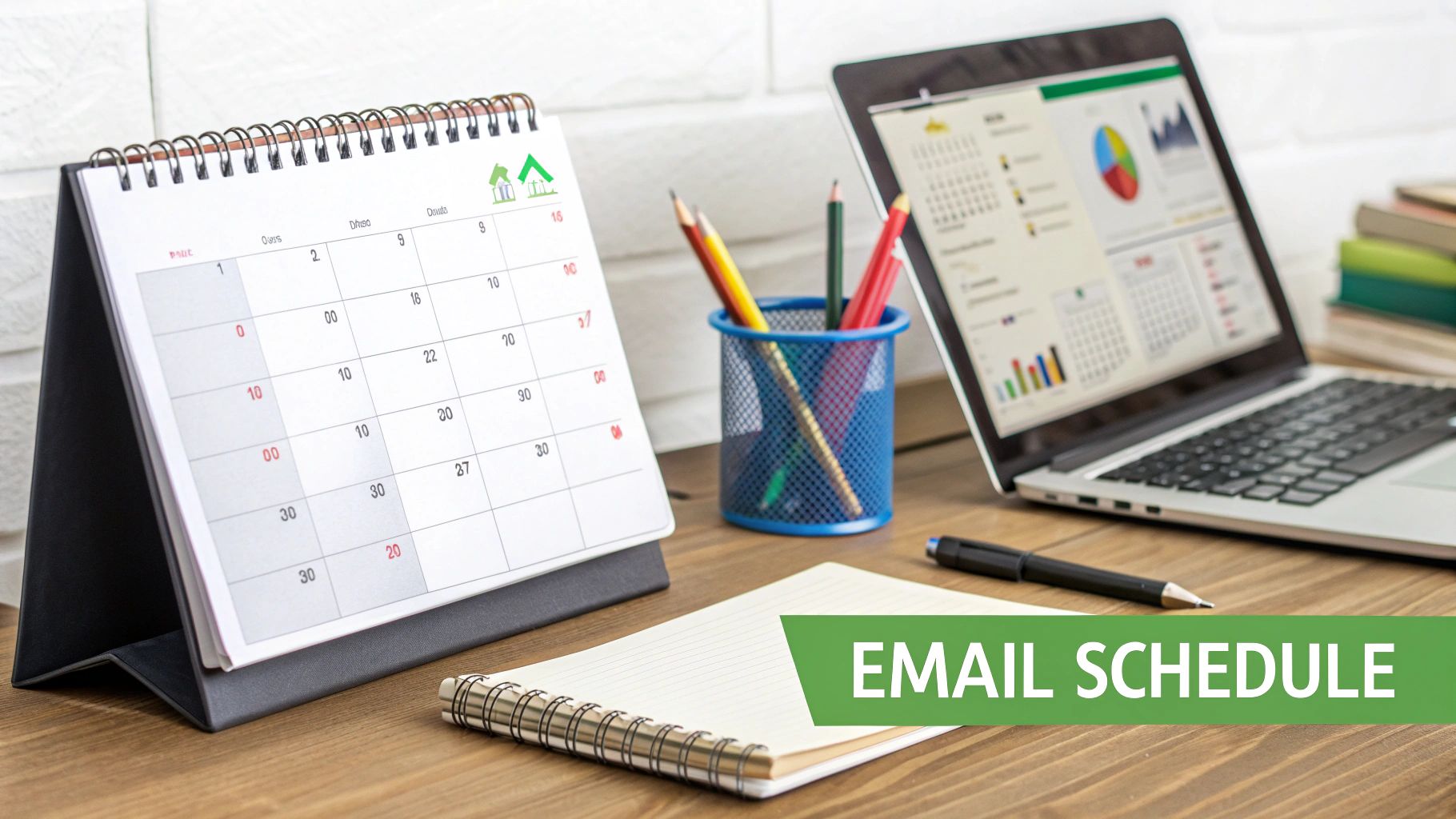
How to Implement Scheduled Email Processing
Adopting this system requires discipline but pays significant dividends in productivity and mental clarity. It's about setting clear boundaries for yourself and others.
- Turn Off Notifications: The first and most crucial step is to disable all email alerts on your computer and mobile devices. This eliminates the Pavlovian response to check your inbox every time a new message arrives.
- Define Your Schedule: Start by scheduling 3-4 specific email sessions per day, such as 9:00 AM, 1:00 PM, and 4:30 PM. Over time, you can adjust this frequency based on your role's demands. For even more strategies, you can learn about different ways to organize your email on typewire.com.
- Communicate Your System: Set expectations with your team and key contacts. Use an autoresponder to inform senders of your schedule, for example: "Thank you for your message. I check and respond to emails at 10 AM and 4 PM each day."
- Keep an 'Urgent' Note: When an idea or a task you need to email someone about comes to mind outside your scheduled blocks, jot it down on a notepad or a digital list. Address it during your next email session to avoid breaking your focus.
4. Email Templates and Canned Responses
Email templates and canned responses are a cornerstone of efficient communication, allowing you to answer common inquiries without drafting messages from scratch every time. This approach involves creating pre-written, standardized responses for frequent scenarios that can be quickly personalized and sent. The core principle is to systemize your replies, saving time while ensuring your communication remains consistent, professional, and on-brand.
This method transforms repetitive email tasks into a streamlined process. Instead of rewriting the same information, you can focus on personalization and addressing the unique aspects of each query. This is one of the most practical tips for email management for anyone in a role that involves high-volume, repetitive communication. For instance, customer service teams at companies like Zendesk and sales professionals using HubSpot rely heavily on templates to manage their workflows effectively and maintain high standards of communication.
How to Implement Email Templates
Getting started with templates is straightforward and offers an immediate return on your time investment. The goal is to build a library of high-quality, adaptable responses.
- Identify Common Scenarios: Begin by analyzing your sent folder to identify the top 5-10 types of emails you write most often. These could be sales follow-ups, customer support answers, or meeting requests.
- Use Personalization Fields: Create your templates with placeholders for key details like
[Name],[Company], and[Specific Detail]. This makes customization fast and prevents generic, impersonal messages. - Organize and Share: Store your templates in a dedicated folder or use your email client’s built-in template feature. For teams, use a shared repository to ensure everyone has access to the most current versions.
- Review and Refine: Your communication needs will evolve. Set a quarterly reminder to review, update, and improve your templates. A/B test different subject lines or calls-to-action to see what generates the best results.
5. The Two-Minute Rule
The Two-Minute Rule, a cornerstone of David Allen's "Getting Things Done" (GTD) methodology, is a simple yet powerful decision-making principle for email. It dictates that if reading, processing, and responding to an email takes less than two minutes, you should handle it immediately. This prevents small, quick tasks from piling up in your inbox, where they create a backlog of "to-dos" that drain your mental energy and create a false sense of being busy.
By acting on these emails instantly, you maintain momentum and keep your inbox from becoming a cluttered task list. This approach is one of the most effective tips for email management because it targets the small items that often cause the most procrastination. Executives use this rule for rapid approvals, while project managers apply it for brief status updates, ensuring communication flows efficiently without delay. This principle empowers you to make swift, decisive actions, clearing the way for more complex work.
How to Implement The Two-Minute Rule
Adopting this rule requires shifting your mindset from deferring tasks to completing them on the spot. Here’s how to integrate it into your daily email routine.
- Practice Estimating Time: Initially, you might misjudge how long a task will take. Consciously practice estimating task duration. With time, you'll become more accurate at identifying which emails fit the two-minute window.
- Combine with Batch Processing: The rule works best when paired with scheduled email sessions. During your dedicated email block, apply the rule to every message you open. This creates a highly efficient processing system.
- Prepare Quick-Reply Templates: For common two-minute responses like confirmations or acknowledgments, create templates. This saves you from typing the same message repeatedly and streamlines your workflow.
- Use on Mobile: Leverage downtime, like commuting, to handle two-minute tasks on your mobile device. Replying to a quick scheduling query or confirming receipt of a document are perfect examples.
6. Email Unsubscribe and List Management
A cluttered inbox is often a symptom of too many subscriptions, not just unprocessed messages. Proactive email unsubscribe and list management is a powerful strategy focused on reducing the volume of incoming email at its source. Instead of just reacting to emails, this approach involves systematically curating what is allowed to enter your inbox in the first place. It’s about taking control of your digital environment by consciously unsubscribing from unnecessary newsletters, promotional lists, and automated notifications.
This method transforms your inbox from a public square into a private, curated space. By regularly auditing and cleaning your subscription lists, you ensure that the emails you receive are relevant and valuable. This is one of the most effective tips for email management because it directly addresses the root cause of digital noise. Busy professionals, for instance, often use services like Unroll.Me to bulk-manage subscriptions, while privacy advocates champion manual audits to maintain control over their data.
How to Implement Email Unsubscribe and List Management
Getting started requires a strategic and consistent approach to cleaning up your subscriptions. This process helps you build a more focused and secure email experience.
- Conduct a Subscription Audit: Dedicate time each month to review your subscriptions. Open your inbox, search for common phrases like "unsubscribe," and make a conscious decision for each sender. Keep what adds value and remove the rest.
- Use Separate Email Addresses: Create distinct email addresses for different purposes. Use one for personal communication, another for online shopping, and a third for professional newsletters. This compartmentalizes incoming mail and makes management far easier.
- Unsubscribe Safely: For legitimate senders, use the unsubscribe link at the bottom of the email. For suspicious or unsolicited emails, it's safer to mark them as spam. Unsubscribing can sometimes confirm your email address is active to spammers.
- Organize Important Newsletters: For subscriptions you want to keep but don't need to read immediately, create a dedicated folder (e.g., "Newsletters" or "Reading List"). Set up a filter to automatically move these emails out of your main inbox, allowing you to read them in a batch later. You can learn how to stop unwanted emails today! for a more in-depth guide on the topic.
7. Email Archiving and Search Optimization
Email archiving and search optimization flips the traditional folder-based organization on its head. Instead of spending valuable time sorting messages into a complex hierarchy of folders, this method prioritizes a "search, don't sort" philosophy. It leverages the powerful search capabilities of modern email clients, turning your inbox into a single, searchable archive. The core idea is to archive every email you've dealt with, trusting that you can retrieve it instantly when needed.
This approach dramatically reduces the cognitive load associated with manual filing and folder maintenance. By relying on search, you eliminate decision fatigue and save time. Professionals in fields like law and research find this indispensable for quickly locating case-related communications or specific data points buried in years of correspondence. This method is one of the most efficient tips for email management because it aligns with how modern data retrieval works: fast, accurate, and on-demand.
How to Implement Email Archiving and Search Optimization
Getting started involves shifting your mindset from filing to finding. This proactive system relies on trusting your email client’s search tools rather than your own manual organization.
- Master Advanced Search Operators: Learn the specific search syntax for your email client. Operators like
from:,to:,has:attachment, and boolean terms likeANDorORcan pinpoint any email in seconds. - Archive Aggressively: Once you have read and taken action on an email, archive it immediately. Don't let it linger in your inbox. This keeps your primary workspace clean and focused.
- Use Strategic Labels or Tags: Instead of dozens of folders, use a few broad labels or tags (e.g., #ProjectX, #Finance, #Urgent). This adds a searchable layer of context without creating a rigid, complex folder structure.
- Develop Keyword Consistency: When sending important emails, be mindful of using consistent keywords in the subject or body. This makes your own messages easier for you and your recipients to find later.
Understanding how to manage your archived data is also crucial for compliance and long-term storage. For a deeper dive into this topic, you can learn more about creating an effective email record retention policy.
8. Email Communication Protocols and Etiquette
Establishing clear communication protocols is one of the most effective, yet often overlooked, tips for email management, especially within teams. These protocols are a set of shared guidelines that define how and when email should be used, creating a predictable and efficient communication environment. The goal is to reduce unnecessary email volume, clarify expectations, and ensure messages are clear, concise, and directed to the right people.
By setting standards for things like response times, subject line formats, and when to use email versus other tools, you eliminate ambiguity and reduce cognitive load. This proactive approach improves communication quality and cuts down on the back-and-forth that clogs inboxes. Companies like GitLab and Buffer have famously documented their communication guidelines, helping their remote teams work asynchronously and efficiently without getting buried in email.
How to Implement Email Protocols
Creating and adopting these standards doesn't require a complex overhaul. A simple, well-communicated document can align your entire team and drastically improve your collective email habits.
- Standardize Subject Lines: Implement a clear convention for subject lines. For example, use prefixes like [ACTION REQ], [INFO], or [URGENT] to signal the email's purpose and priority at a glance, allowing recipients to triage their inboxes more effectively.
- Define Response Times: Set realistic expectations for replies. A common standard is a 24-hour response time for non-urgent matters. This prevents the anxiety of needing to reply instantly and allows for focused work.
- Clarify Communication Channels: Create a simple guide for when to use email versus other tools. Use email for formal announcements and documented decisions, a chat tool like Slack for quick questions, and video calls for complex discussions.
- Create a Protocol Document: Draft a one-page document outlining these rules. Share it with your team, gather feedback, and make it easily accessible. Regularly review and update it to reflect the team's evolving needs.
8 Email Management Strategies Comparison
| Methodology | 🔄 Implementation Complexity | ⚡ Resource Requirements | 📊 Expected Outcomes | 💡 Ideal Use Cases | ⭐ Key Advantages |
|---|---|---|---|---|---|
| Inbox Zero Methodology | Intermediate to Advanced | 15-30 min daily once established | Reduces backlog, lowers stress, improves control | Users with manageable email volume wanting immediate processing | Reduces anxiety, increases productivity |
| Strategic Email Filtering and Rules | High initial setup complexity | 2-4 hours initially + monthly maintenance | Automates sorting, prioritization, time-saving | Teams handling large volumes and diverse email flows | Consistent organization, automation |
| Scheduled Email Processing | Moderate | 20-45 min per session, 2-4 times/day | Reduces interruptions, increases focus | Roles tolerating delayed responses, focus-intensive jobs | Improves focus, batch efficiency |
| Email Templates and Canned Responses | Low to Moderate | Initial time investment for creation | Saves 70-80% email composition time | Customer service, sales, HR teams with repetitive emails | Saves time, ensures consistency |
| The Two-Minute Rule | Low | None to minimal | Reduces backlog by 60-70% | Professionals handling mixed urgent and routine emails | Simple, fast decisions, prevents buildup |
| Email Unsubscribe and List Management | Low to Moderate | Monthly audits recommended | Decreases daily volume by 40-60% | Users overwhelmed by newsletters and promotions | Reduces distractions, lowers volume |
| Email Archiving and Search Optimization | Moderate | Learning curve for advanced search | Speeds retrieval 5-10x vs. folders | Users with large email volumes favoring search over folders | Fast retrieval, reduces organization load |
| Email Communication Protocols and Etiquette | High (organization-wide) | 2-4 weeks adoption time | Improves communication quality 30-50% | Teams seeking clear email use standards and etiquette | Reduces volume, sets clear expectations |
Your Next Step Towards a More Secure and Organized Inbox
We have journeyed through a comprehensive suite of strategies designed to transform your inbox from a source of stress into a tool for productivity. From the disciplined clarity of the Inbox Zero methodology to the time-saving efficiency of templates and the Two-Minute Rule, each tip offers a distinct path toward digital order. We explored how strategic filtering can automate your organization, how scheduled processing can reclaim your focus, and how diligent list management can permanently silence unwanted noise.
The power of these techniques lies not in their complexity but in their consistency. Implementing even one or two of these tips for email management will yield noticeable results, reducing mental clutter and freeing up valuable time. The true mastery, however, comes from weaving these habits together into a cohesive system that works for you, not against you.
From Strategy to System: Building Your Email Fortress
Think of these tips as individual bricks. On their own, they are useful, but when combined, they build a formidable structure.
- Foundation of Control: Start with strategic unsubscribing and aggressive filter creation. This immediately lessens the incoming flow, giving you the breathing room to implement other changes.
- Walls of Efficiency: Apply the Two-Minute Rule and scheduled email processing blocks to manage the emails that remain. This creates a resilient barrier against constant interruptions and reactionary work.
- The Secure Roof: Layer on proper communication etiquette and a robust archiving strategy. This protects your professional reputation and ensures valuable information is always retrievable without cluttering your active workspace.
The ultimate goal is to move beyond simply coping with email to commanding it. This is not about finding a single magic bullet, but about building a personalized, sustainable system. An organized inbox is a direct reflection of an organized mind, and the clarity you gain will extend far beyond your email client. It empowers you to focus on high-impact work, communicate more effectively, and protect your most valuable asset: your attention.
Adopting these powerful tips for email management is a significant step forward. However, the security and privacy of the platform you use are just as critical. A cluttered, ad-filled, or insecure email service can undermine even the most disciplined efforts. Your strategies are only as effective as the environment they are implemented in. By combining a systematic approach with a tool built for security and focus, you create an truly optimized communication hub.
Ready to pair these powerful strategies with an email platform built for privacy and productivity? Typewire provides an ad-free, no-tracking environment with advanced security features, giving you the perfect foundation to implement these tips for email management. Take control of your digital communications and build a more secure, organized inbox today by visiting Typewire.

